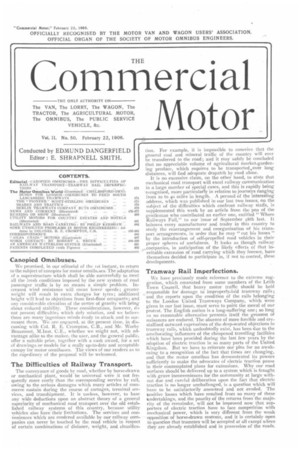Canopied Omnibuses.
Page 1

If you've noticed an error in this article please click here to report it so we can fix it.
promised, in our editorial of the ist instant, to return to the subject of canopies for motor omnibt.ses. The adaptation of a superstructure which shall be able successfully to meet all the fresh conditions imposed by the new system of road passenger traffic is by no means a simple problem_ Increased wind resistance will mean lower speeds; greater weight will result in extra charges for tyres; additional height will lead to objections from first-floor occupants; and any considerable elevation of the centre of gravity will bring about reduced stability. These considerations, however, do not present difficulties which defy solution, and we believe there are many ingenious minds ready to attack and to surmount them. We are engazed, al the present time, in discussing with Col. R. E. Crompton, C.B., and Mr. Worbv Beaumont, M.Inst. C.E., whether we might not, with advantage alike to the maker, the user, and the general public, offer a suitable prize, together with a cash award, for a set of drawings or models for a really up-to-date and acceptable canopy for motor omnibuses. The views of our readers as to the expediency of the proposal will be welcomed.
The Difficulties of Railway Transport.
The conveyance of goods by road, whether by horse-drawn or mechanical plant, would be universal were it not frequently more costly than the corresponding service by rail, owing to the serious damages which many articles of commerce sustain during the course of cartages, terminal services, and transhipment. it is useless, however, to base any wide deductions upon an abstract theory of a general superiority of mechanical road transport over the old established railway systems of this country, because utility vehicles also have their limitations. The services and conveniences which are rendered available by our railway companies can never be touched by the road vehicle in respect of certain combinations of distance, weight, and classifica
tion. For example, it is impossible to conceive that the general coal and mineral traffic of the country will ever be transferred to the road; and it may safely be concluded that no appreciable volume of agricultural market-gardening prodUce, which requires to be transported„over long distances, will find adequate despatch by road alone. It is no excessive claim, on the other hand, to state that mechanical road transport will excel railway communication in a large number of special cases, and this is rapidly being recognised, more particularly in relation to journeys ranging front TO to 40 miles in length. A perusal of the interesting address, which was published in our last two issues, on the subject of the difficulties which confront railway staffs, is supplemented this week by an article from the pen of the gentleman who contributed an earlier one, entitled "Where Railways Fail," to our issue of September 28th last. It behoves every manufacturer and trader in this country to study the rearrangement and reorganisation of his transport arrangements, in order that he may "cut his losses " by the introduction of self-propelled road vehicles in their proper spheres of usefulness. It looks as though railway „companies, in anticipation of the likely effects of that inevitable extension of road carrying which they foresee, have themselves decided to participate in, if not to control, these developments.
Tramway Rail Imperfections.
We have previously made reference to the extreme suggestion, which emanated from some members of the Leith Town Council, that heavy motor traffic should be held responsible for damage to improperly-laid tramway rails; and the reports upon the condition of the rails belonging to the London United Tramways Company, which were given in our last issue, must serve to point the moral of our protest. The English nation is a long-suffering one; so long :is no reasonable alternative presents itself the grossest of nuisances are endured. The absence of more forcible and crystallised outward expressions of the deep-seated objections to tramway rails, which undoubtedly exist, has been due to the ameliorating influences of the cheapened travelling facilities which have been provided during the last few years by the adoption of electric traction in so many parts of the United Kingdom. But we have to reiterate our plea for an awakening to a recognition of the fact that times are changing, and that the motor omnibus has demonstrated its powers sufficiently to make the advocates of electric traction pause in their contemplated plans for extensions. Why our road surfaces should be delivered up to a system which is fraught with grave inconveniences for the community at large without due and careful deliberation upon the fact that electric traction is no longer unchallenged, is a question which will have to be satisfactorily answered and not evaded. The Positive losses which have resulted from so many of these undertakings, and the paucity of the returns from the majority of the remainder, will not be improved now that supporters of electric traction have to face competition with mechanical power, which is very different from the weak opposition-of horse-drawn systems, and it is certainly open to question that tramcars will be accepted at all except where they are already established and in possession of the roads.




















